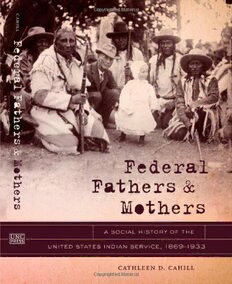
Federal Fathers and Mothers: A Social History of the United States Indian Service, 1869-1933 (First Peoples: New Directions in Indigenous Studies) PDF
385 Pages·2011·3.051 MB·English
Most books are stored in the elastic cloud where traffic is expensive. For this reason, we have a limit on daily download.
Preview Federal Fathers and Mothers: A Social History of the United States Indian Service, 1869-1933 (First Peoples: New Directions in Indigenous Studies)
Description:
Established in 1824, the United States Indian Service, now known as the Bureau of Indian Affairs, was the agency responsible for carrying out U.S. treaty and trust obligations to American Indians, but it also sought to "civilize" and assimilate them. In Federal Fathers and Mothers, Cathleen Cahill offers the first in-depth social history of the agency during the height of its assimilation efforts in the late nineteenth and early twentieth centuries.Making extensive and original use of federal personnel files and other archival materials, Cahill examines how assimilation practices were developed and enacted by an unusually diverse group of women and men, whites and Indians, married couples and single people. Cahill argues that the Indian Service pursued a strategy of intimate colonialism, using employees as surrogate parents and model families in order to shift Native Americans' allegiances from tribal kinship networks to Euro-American familial structures and, ultimately, the U.S. government. In seeking to remove Indians from federal wardship, the government experimented with new forms of maternalist social provision, which later influenced U.S. colonialism overseas. Cahill also reveals how the government's hiring practices unexpectedly allowed federal personnel on the ground to crucially influence policies devised in Washington, especially when Native employees used their positions to defend their families and communities.
See more
The list of books you might like
Most books are stored in the elastic cloud where traffic is expensive. For this reason, we have a limit on daily download.
